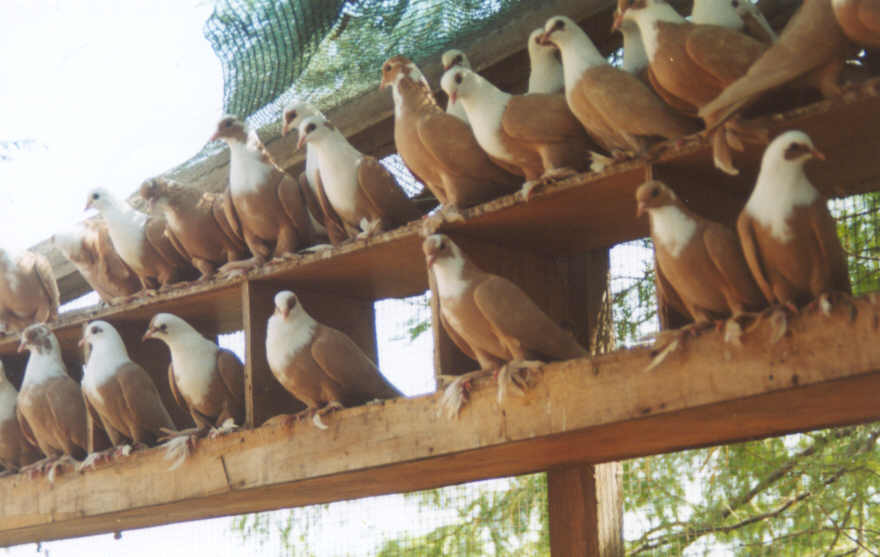
Sherzi Tumblers *
by late H.P.MACKLIN
 |
These Tumblers originated probably in Persia (Iran). Sam Shadeed of Jacksonville, North Carolina, imported them to the U.S. in 1954 from Damascus, Syria. In Syria Shakhsharll means "over-dressed" and Sherazi means 'coming from Sheraz (Persia).' The latter name is good evidence that the Syrians do not claim it as a native breed.
The
Sherazi is a flying Tumbler, small, averaging 13 oz. It is plain headed and
small muffed, about one inch on the toes. It is bred in black, blue, red, yellow
and cream (barred yellow). The plumage is colored except for a white head and
neck, the white extending to the bottom of the neck on the back and deep in
front on the breast. There may be a colored spot on the top skull and on the cheeks. Some times the entire head and cheeks
are white. Also, usually a pitch of white on the rump, silver dollar
in size. The eye is pearl. 'Me muffs are usually colored but can be white.the
markings are not well fixed since in Syria the variety Is raised only for air
performance. An unusual breed that has not gained the wide popularity in the
U.S. that was expected of it.
Mr.
Lexi's book also shows two nice examples of the Sherazi in blue and black. 1
have taken the liberty of making the head spots uniform. Usually The head design
is anything but symmetrical.
My
German book has this to say about the variety :the Syrian shakhsharli tumblers
are related to the Indian
Sherajee pigeon and also with the Lahore. they are good flyers and of medium
size. The head is rounded and can be crested or smooth headed. The eyes are
either pearl or dark, beak medium long, mostly flesh colored. 'The neck is
medium long, the throat nicely formed. 'Me back and tail form an unbroken line
down- ward. Wings rest above the tail. The 12 feathered tall is held in a tight,
narrow position. no foot feathering is short and should cover only the toes, but
this is rarely the case.
the
design is rather peculiar. Body is colored; white head and neck to breast line.
Cheeks and top skull are color spotted. the cheek spots are under the eyes.
Pigeons with these head markings are in truth seldom seen as the Syrians place
the flying ability definitely first. the exhibition value of these Tumblers in
America would indeed be good but due to the imperfections in their design too
much would have to be overlooked.
Personal
Comment: If my memory serves me right 1 received two pairs of Sherazi
Tumblers from Mr. Shadeed some tirne after he imported them to the U.S. In fact,
we corresponded almost weekly because 1 was recording
all the various Syrian breeds of pigeons for my 'pigeon Portraits "
series that he was importing at the time.
1
felt confident this little Tumbler would catch on in the U.S. because the design
was so unique the birds simply caught your eye from the far end or the loft 1
had the dark blue bars
and blacks. They were fast producers and good
parents but there simply was no controlling the head design. Mainly the spots
were uneven and frequently, misplaced. 'I he only consistent markings were the
round white spots on ' he rumps which 1 never Red on the birds. Also the white
neck was usually evenly bordered at the neck base. Another marking that
intrigued me was in the foot feathering. The very short muffs were black but the
feathers on the toes were always white, making a nicely finished border to the
design This muff
marking was also rather consistent. 1 never did produce young
with Just the toes feathered and the legs bare, as mentioned by the
German fanciers.
I
worked with these Tumblers for several years trying to line up the head markings
but to no avail. 'Men 1 tried to breed out the spots and just have a solid white
head and neck. I had a few marked this way and tl,7
were really beautiful birds. But the spots appeared more often than not
and I finally gave up.
what
puzzles me was how those Syrian fanciers ever produced the markings as well
developed as they had. Around 1950 there were few, if any, exhibitions held in
that country and the local fanciers bred those birds for flying only, not
markings. No records were kept and banding was unheard of; so how could this
Tumbler have developed this odd design just from indiscriminate breeding?
*APJ
JUNE 1978